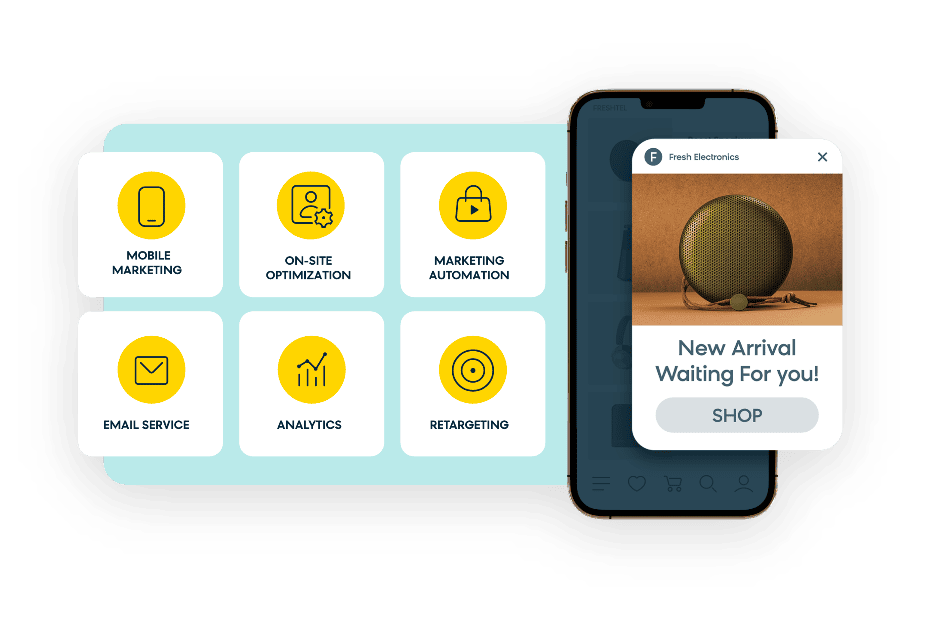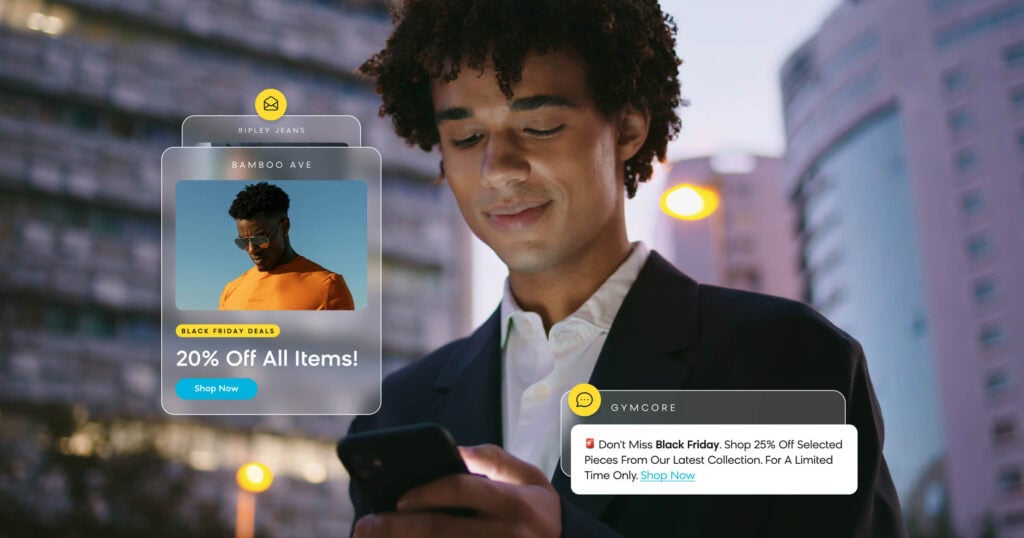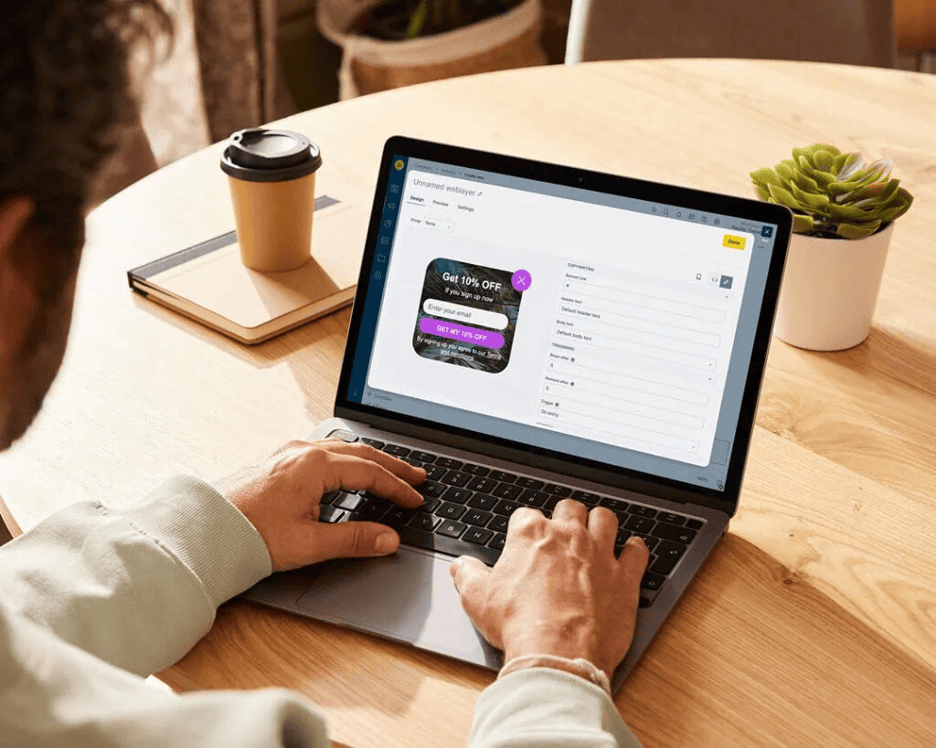Introduction
In today’s market, data is everything. Having marketing technology capable of collecting customer and product data compliantly is one of the most important building blocks of success with ecommerce personalization.
This combination of customer and product data is called commerce data— and creating truly personalized and connected commerce experiences for your customers online is nearly impossible without it.
It isn’t enough to just create an e-shop any more. Digital is no longer just a supporting channel to companies’ brick-and-mortar stores. If the first 20 years of ecommerce were about standing up a store, the next 20 years are about how to make that store stand out from the crowd.
Digital is now the primary channel for many shoppers, and before you can build any brand loyalty, you have to first meet their demands for a better experience online.
The research also makes it clear that personalization should be a priority. Consider these three eye-opening data points from McKinsey:
76% of consumers become frustrated when they don’t get a personalized experience
76% of consumers are more likely to consider purchasing from companies that use ecommerce personalization strategies
78% of consumers are more likely to make a repeat purchase with a brand that personalized their online shopping experience
With those numbers in mind, it’s easy to see why companies all over the world are putting ecommerce personalization into action. But it takes more than just commerce data to do that — it takes a marketing technology stack that supports data acquisition and then actionability with that very same data. It takes a customer-centric approach to business that puts your customers at the center of every decision that your company makes.
And maybe most importantly, it takes buy-in from the C-suite down on the idea that ecommerce personalization is more than just a passing fad — it’s the wave of the future that has changed digital commerce forever.
It all starts with your company’s marketing technology stack. It has to provide the answer to some incredibly important questions that will define your company’s future in our new fully digital age.
What data does your company already collect? What data does it want to collect in the future? How easy is it to take action with that data? How does it want to communicate with customers? How does it want to acquire new customers and retain returning customers?
Consider all of those questions as we dive deeper into how to build a martech stack with ecommerce personalization in mind.
Comprehensive Data Platform
Ecommerce personalization starts (and ends) with data. However, what should you look for in a data platform? At a high level, you need a data platform that compliantly collects customer data, transforms it into actionable data sets, and integrates among all aspects of your marketing efforts.
However, finding all of that in one place is easier said than done. Let’s examine the core features that your data platform needs to have in order to be effective in delivering personalized marketing campaigns efficiently and at scale to drive revenue.
First, your data platform needs to be able to pull in commerce data from everywhere, from both online and offline sources. These integrations of online and offline systems are key to truly understand what your customers are looking for and what products they are likely to search for both online and in-store.
After having online and offline channels brought together in one platform, you next need to be able to visualize how customers interact with each channel. A comprehensive data platform should build a complete picture of your customers on an individual level, what channels they interact with, what times they are most likely to interact with marketing campaigns, and make recommendations on what marketing channels you should send them next.
A good data platform collects first-party customer data (transactional, behavioral, demographic) from a multitude of sources and systems, and links that information to each individual customer. This creates a 360-degree customer profile, also called a single customer view.
Finally, you need to be able to compile all these customer profiles into segments that build the basis for individual campaign initiatives. It’s one thing to be able to build segments, but it’s another to automatically keep them updated and change segments as customer behavior changes. Segments that can’t update automatically can lead to old messaging that doesn’t resonate, effectively rendering your personalization efforts useless.
Put Comprehensive Data Into Practice
By utilizing a data platform as described above, commerce marketers are able to create truly 1:1 personalized experiences for their customers at scale. No longer will you have to manually move customers from one campaign to another. No longer will customers get the same marketing messages that may or may not apply to the products they purchase from you. No longer will the data not be owned by your marketing team. Instead, you will be able to send the right messages that resonate with each individual customer at the precise time they are most likely to engage and purchase.
Email Service Provider (ESP)
An email service provider (ESP) is exactly what it sounds like — a service that offers email marketing or bulk email capabilities.
For all of the advances we have seen in technology in the digital era, email is still one of the most important channels in any company’s arsenal. That’s why email deliverability is so essential.
There are somewhere in the neighborhood of 270 billion emails sent every day worldwide. Consider your own inbox for a moment. How many emails do you receive per day? 25? 50? 100? It’s important to understand that by using an ESP and with email marketing in general, you certainly won’t be the only company tapping into this universal strategy.
But that doesn’t mean you can’t stand out doing it.
A good ESP sends, receives, and tracks your email messages. It should allow you to send and track your marketing communications effortlessly and should allow you to build campaigns with ease. A good ESP will help you do all you can to avoid spam traps, improve your deliverability, and drive higher conversion rates from marketing messages.
Why bother with email marketing in the first place? It’s a very effective method to increase sales by making customers aware of the products or services that you’re offering. Specifically, it allows you to:
- Advertise key products or sale items to certain segments of shoppers that you feel are more inclined to purchase
- Compel people to become more invested in your brand thanks to recurring newsletters or company updates
- Ultimately, increase customer lifetime value by building a stronger relationship with your customers
Add Data Segments Into Your Email Practice
By using the data segments in your data platform and applying them to email, marketers can make more effective campaigns to re-engage customers. For example, if you notice you have a large issue with abandoned carts, you can create a segment of customers who all abandoned their carts within a given timeframe. By using this segment within your ESP, you can create an automated email that includes their items left in cart, accompanied by a discount code, that links them to the exact place they left off, sent at the exact time they have historically interacted with your emails in the past. This leads to higher open and click-through rates in your email, while also conveying to the customer that you understand what’s most important to them.
Mobile Marketing (SMS/MMS/Push Notifications)
If using an email service provider is old faithful, mobile marketing represents the future of digital marketing.
What is mobile marketing? A multi-channel online marketing technique that is focused on reaching people who — yes, you guessed it — use their mobile devices (smartphones, feature phones, tablets, etc.) to access the content being disseminated.
For our purposes, we will focus specifically on MMS messaging, SMS messaging, and push notifications, which all can be grouped under the umbrella of “messages that can be received on mobile devices.”
Thanks to built-in APIs, collected customer data, and messaging software, companies can create personalized and product-specific automated messages to send to their customers in real time to help reengage them and guide them through the customer journey with their brand.
MMS is a built-in channel to send multimedia content via mobile that allows for an engaging and branded way to reach customers where they are most active. With MMS messaging, brands can personalize content with zero-party or first-party data to target high-intent audiences. This makes converting abandoned carts, engaging your most loyal customers, and welcoming new users very simple.
SMS is a direct messaging tool that allows for one-to-one communication with customers. You can reach customers with personalized messages and also receive responses to these messages and take appropriate action.
Mobile push notifications can also serve a similar purpose. These are textual push notifications that can feature additional media (images) and interaction (buttons) that you can send to your mobile app users. With so many customers interacting with your brand via their mobile devices nowadays, you can’t miss the opportunity to connect with them where they are.
Put Mobile Marketing Into Practice
Pro tip — don’t just make your mobile marketing efforts an extension of your email marketing campaigns. Customers who are receiving your mobile notifications have little tolerance for impersonal communications. A “batch and blast” approach is doomed to fail. Instead, you need to consider your audience when you use mobile marketing tactics. Use the single customer view to help personalize messages with appropriate product recommendations or other personalized content based on segments. Enhance the customer experience by notifying customers about promotional offers or by leading them to specific places to complete a purchase. Just ensure this strategy is tailored to mobile, not just copy and pasted from email.
Marketing Automation Platform
Businesses can grow rapidly thanks to acquiring new customers and building relationships with them effectively, but that growth can also become overwhelming. That’s why many companies turn to marketing automation.
But it can’t just be automation for the sake of automation. Good marketing automation helps you deliver meaningful personalized experiences to customers at the right time and in the right channel. Thus, good marketing automation is built on a solid foundation of customer understanding and actionable data.
Data is rocket fuel for smart marketers. And good marketing automation takes full advantage through a number of key use cases.
Trigger personalized campaigns. Certain stretches of customer journeys are fairly predictable, and in those cases you want an automated campaign that triggers at just the right moment. Think about an abandoned cart that triggers an email, a birthday reactivation campaign that goes out to every customer on their day of the year, or even a campaign that lets a customer know the sweater he looked at is back in stock.
Use history to predict the future. If you have enough data, you’ll be able to accurately predict more about your customers. If you know a customer is likely to churn and never purchase from you again, you want them to automatically get a personalized offer. Similarly, if you know the customer is likely to make a purchase, you can hold off on sending them the free shipping campaign and save it for their next purchase.
Easily analyze and manage automated use cases. As your usage of marketing automation grows, it becomes crucial to accurately report on the success and uplift your program is generating. At the same time, there are more and more use cases to manage every day, and you need a platform that enables you to do that quickly and efficiently.
A visual drag-and-drop scenario builder that enables smart marketers to orchestrate omnichannel campaigns in a single UI is essential to making these use cases possible. It makes sure the message is consistent on all channels and the communication is focused on the customer while respecting the channel specifics, and not the other way around.
Put Marketing Automation Into Practice
One of the most important questions that must be asked when your solutions are being implemented is: “How quickly can we begin to drive value?” Out-of-the-box marketing automation campaigns are important because they can allow businesses to begin using their new solution immediately to drive revenue while they are learning the ins and out of it. Will your new solution allow you to, for example, set up key ecommerce flows like abandoned cart or an automated welcome email series to help generate revenue from low-hanging fruit? Having customer-centric marketing automation use cases is important at every stage of operating your martech stack, but it is especially important early on to begin the process of driving revenue and personalizing content for your customers.
On-site Optimization and Personalization
The data you’ve collected doesn’t just have to serve you for omnichannel campaigns. It can be put to work on your website as well.
There isn’t a much better user experience than a customer navigating to your website and immediately seeing the perfect recommendation. Recommendations generate an important portion of revenue for the world’s biggest companies, including Amazon, Netflix, and eBay.
These companies, and many more, place these product recommendations on their homepage, category detail pages, product detail pages, checkout page, and a myriad of other locations that customers are likely to convert from. Your personalized product recommendations must leverage all your customer and catalog data to find the most suitable items for each individual customer in a given situation.
Let’s look at product recommendations with a contentious tool: pop-ups. Many people find them incredibly annoying, but that’s because they aren’t often used correctly.
The key with pop-up experiences on your website is to get the context, content, and audience correct. Instead of treating pop-ups and banners as digital loudspeakers, think of them as just another communication channel to reach your customers. Apply the same personalized and segmented approach that you would with email or mobile marketing tactics.
Ask yourself key questions — is this offer being displayed attractive enough? Is the content relevant to those seeing the banner? If the answer to those questions is no and you display it anyway, you run the risk of customers exiting your site as quickly as they signed on.
Don’t forget that sometimes small changes can make all the difference with personalization. Running A/B tests and analyzing the results can make a massive impact on your commerce-driving team. If your marketing technology stack has the capability to make instant adjustments to your website design based on those results, you can easily implement important changes that make a big difference to the bottom line.
Put Onsite Personalization Into Practice
Many vendors in today’s market can offer some type of solution that can offer personalized product recommendations to repeat visitors. But how many can offer real-time recommendations to first-time visitors? Being able to personalize the experience of a first-time visitor is a differentiator in the digital age. This powerful approach ensures that all of your visitors get a personal touch during their first interaction with your brand and considerably increases the possibility of a conversion on that first visit. Think bigger with product recommendations and keep first-time visitors in mind.
Retargeting/Ad Audience Management
Many companies in the digital age are acquiring customers through social media and other frequently visited websites. They are doing this through behavioral retargeting and ad audience management.
Behavioral retargeting is a form of online targeted advertising where ads are targeted to consumers based on their previous internet behavior. Retargeting tags online users by including a pixel within the target webpage or email, which sets a cookie in the user’s browser.
The death of (or impending death of) third-party cookies and third-party tracking has made retargeting much trickier. Winning in a cookieless world has become top of mind for nearly every company doing business online.
When Firefox and Safari shut down the support of third-party cookies and third-party tracking to enhance the protection of internet users, it created a profound shift away from the use of third-party data and towards the use of zero-party and first-party data.
With the combination of good first-party data and a group of loyal customers whose consent you’ve gained, you can improve your ad campaign performance as well. Implementing server-side conversion tracking and audience management tactics can go a long way in making Facebook and Google revenue positive for your company again.
Put Ads Retargeting Into Practice
Advertising with Facebook Ads has been the lifeblood of many companies across the globe. But as privacy laws have become more complicated, so has advertising with Facebook Ads. Consider a tool like Facebook Conversions API (FB CAPI) to help. The FB CAPI integration offers the possibility of sending important events, such as purchases or leads, to Facebook Ads. That, in turn, allows for better optimization of Facebook Ad campaigns. The solution directly responds to the decreased reliability of the Facebook pixel and offers brands more control over what data is being sent to Facebook. The API allows you to send events directly to the Facebook Ads platform without having to rely on browser pixel tracking.
Loyalty Programs
A loyalty program provides customers with an opportunity to receive rewards in returning for providing data to your company.
This allows brands to obtain layers of data that had previously been inaccessible, such as where their customers are coming from, how frequently they’re visiting your website, and which items they’ve browsed.
By using loyalty program data for customer characteristics, demographics, buying patterns, and pain points, you’ll be able to personalize your offers effectively. You’ll also be able to use more effective language and incentives that will attract customers and drive conversion.
By rewarding customers with points, coupons, discounts, or other small gifts, you can incentivize them to share more data. That data will then lead to a more personalized experience with your brand — with the right marketing technology stack supporting those efforts.
It’s simple to collect demographic, behavioral, and preference data through a loyalty program, which in turn lets you deliver connected experiences by personalizing every touchpoint across all channels.
Put Loyalty Programs Into Practice
The best way to get started with a loyalty program is to simply…start a loyalty program! Assign loyalty tiers based on purchase behavior, email engagement, and browsing history and connect it to automated email campaigns that notify customers of their higher status, perks, and rewards. This will lead to increased brand loyalty and ideally drive more revenue. The marketing psychology tactic of reciprocation is in play here. Because of the value you provided the customer with the perk or reward, the customer will in turn want to be loyal to the company.
Learn more: Don’t be afraid to think outside the box with your customer loyalty program. There are different types of customer data that you may not have known your loyalty program could help you collect.
Omnichannel Campaigns
Customers interact with brands in a multitude of different ways. Each interaction should be intuitive, informed by the previous interaction, and make consumers feel as if they are having a connected commerce experience with your company.
Omnichannel commerce is a multichannel approach to sales that focuses on providing a seamless customer experience whether the consumer is shopping online from a mobile device, a laptop, or in person at a brick-and-mortar store.
Having the capability via your marketing technology stack to execute omnichannel campaigns gives your commerce-driving team total control over every aspect of the customer journeys. A good martech stack allows your team to add real-time triggers, customer segments, conditions, and channels, as well as design end-to-end automated omnichannel flows.
To give consumers the highly personalized experience they long for, your tech stack needs to have the ability to connect to third-party services through built-in integrations, or use API to make collected data actionable across multiple channels.
Omnichannel campaigns adapt to your customers’ behavior in real time and allow your company to have a safety net against delivering campaigns with messages that are ineffective or not timely. No matter which channel your company chooses for its campaign, your marketing techology stack should facilitate simple management of that campaign, no matter how complex it may be.
If the goal is to deliver unified customer experiences across all digital touchpoints, you must equip your commerce-driving team with the right marketing tech stack to achieve that goal. That includes the ability to design end-to-end automated omnichannel flows that natively integrate all of your channels within a single platform.
Put Omnichannel Campaigns Into Practice
One of the best uses of smart machine learning and artificial intelligence is predicting customer behavior and then using those predictions for omnichannel campaigns. This is key to ensuring that the right customer receives the right message at the right time from your business. Whether that’s finding the best time to send an email or knowing exactly what channel to communicate on, use your collected customer data to inform these campaigns rather than guessing.
Dashboards and Analytics
What good are all these emails, messages, and campaigns if you don’t know how they perform?
It’s almost equally as important to be able to track the performance of your campaigns than to actually execute the campaigns themselves. That’s where dashboards and analytics come in.
Dashboards are a tool for neatly displaying relevant pieces of data from across your entire martech stack. Using dashboards makes it easy for anyone in the company to see all of the key metrics and trends about marketing in a single place. More importantly, that place can become a single source of truth, so you can avoid any debates on whose data is actually the right data.
Analytics, on the other hand, is the ability to dive deeper into the data, and better understand things like why sales were trending down in a specific quarter, which segment drove the most revenue, and which channels are performing the best relative to their budgets.
Analytics has become the backbone of smart marketing departments everywhere, and continues to pay dividends when marketers get access to quality data and tools to find meaningful insights.
Cohort analytics, real-time reporting, building custom metrics, and calculating customer attributes like customer lifetime value can be done in seconds and without the need to involve other departments and technical people — if you choose the right tools.
And while it can be scary at first, the marketers who’ve made the switch would never go back.
How do you stack up? Do you run campaigns because “it’s best practice” or “that’s the project”? Or can you confidently analyze the impact of your campaigns on the company bottom line?
Put Dashboards and Analytics Into Practice
You know the importance of testing. And testing. And doing more testing. But after you’re done testing, you have to be able to analyze those results appropriately. Capturing and visualizing instant insights from your campaigns across all of your different channels should be a capability that your martech stack supports. You should be able to dig as deep as you want into the data you’ve collected to reveal connections betweens data that you might have previously thought was unrelated.
Consent Management
With non-compliance fines for local regulations such as the General Data Protection Regulation (GDPR) soaring and customers more concerned about their personal data than ever, consent management cannot be the forgotten element of your tech stack.
Consent management is a system or process for allowing customers to determine what personal data they are willing to share with a business. It has become so important worldwide because of the lawful requirement for websites to obtain user consent for collecting data through cookies while browsing.
Businesses everywhere are now responsible for collecting and managing customer consent, and this has to be a consideration before deploying marketing campaigns or email communication efforts.
A good consent management process logs and tracks consent collection so that companies don’t need to worry about being in compliance with worldwide laws and regulations. It also, of course, facilitates the collection of consent.
Why does consent management matter? The million dollar question. Quite literally, for some companies.
Ignore consent management at your own risk. GDPR fines have skyrocketed in the digital age as consumers have begun to care deeply about protecting their personal data, with fines potentially reaching $20 million or 4% of the annual global turnover of a company. Imagine trying to explain that to your boss in your next staff meeting.
Put Consent Management Into Practice
Manage your subscription policies and track changes to consents for your customers with consent management. That’s the name of the game. Consider making these the main features of your consent management process:
- A definition of your own consent categories that customers can subscribe to Subscriptions based on a legitimate interest
- A lifetime overview of the whole consent history for every customer (being able to see who, when, and where a customer gave or withdrew consent)
- A customizable consent management page for customers
Find a vendor who can support consent management at that level so your company isn’t paying later.
Putting the Pieces Together
Breaking things down use case by use case is helpful in understanding the tools and capabilities necessary to personalize customer experiences in ecommerce. But putting together the entire puzzle helps your company paint a clear picture of your personalization plan and more importantly, helps to put that plan into action to drive revenue.
In a perfect world, a comprehensive data platform compliantly collects data and feeds that data out for personalized campaigns. Those personalized campaigns include email, mobile, marketing automation, a loyalty program, and other omnichannel campaigns. Supporting those campaigns should be the dashboards and analytics that help your company draw important insights and the consent management process that keeps you compliant with governing laws and regulations.
All those pieces work together to personalize content and campaigns for first-time visitors and loyal customers. Powering personalization with marketing technology solutions will unlock commerce growth and truly represents the wave of the future in digital commerce.
How will your company do it?
Experience Limitless Marketing for Yourself
See our composable personalization platform in action and learn how to streamline your workflows, elevate the customer experience, and drive bottom-line impact.






